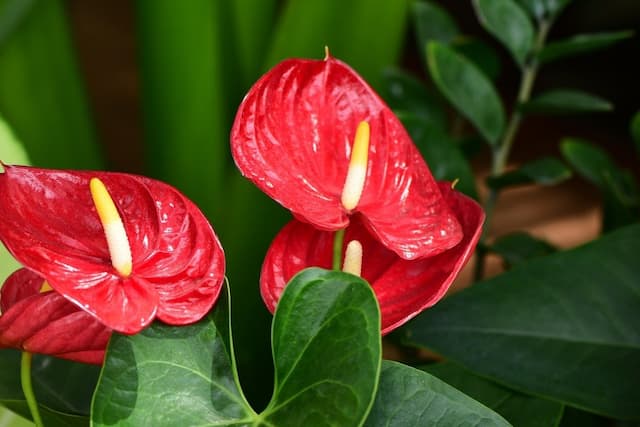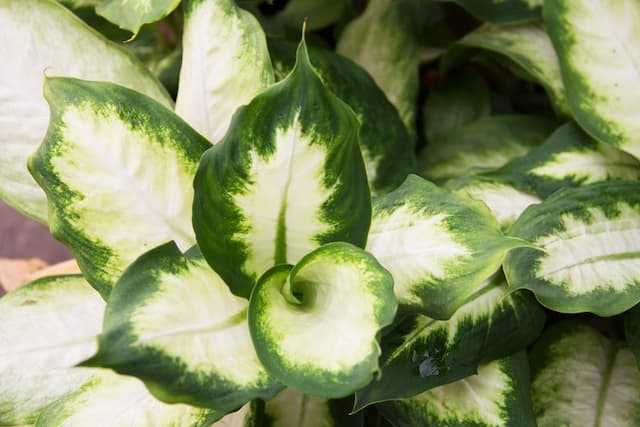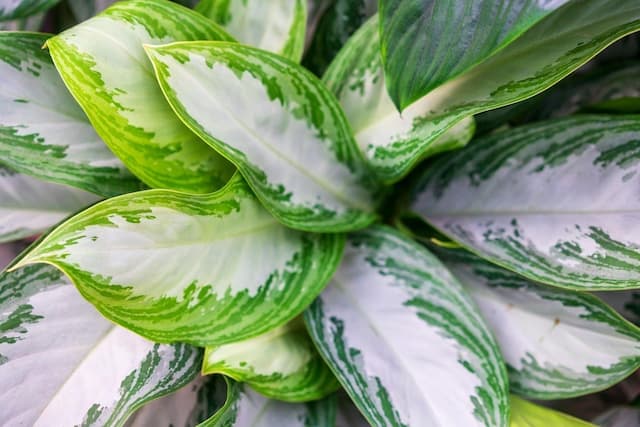ZZ Plant Zamioculcas zamiifolia



ABOUT
Zamioculcas zamiifolia, also known as Fern arum and Zanzibar gem, is a tropical evergreen perennial plant that is native to Eastern Africa. It has glossy, dark green leaves that are arranged in a symmetrical rosette pattern. The leaves are thick, fleshy and glossy with a slightly curved shape. They are about 1-2 inches wide and 2-4 inches long.
The leaves are arranged on long, thick stems that arise from a rhizome. The plant grows slowly and can reach a height of about 2-3 feet, it is a slow-grower and can take several years to reach its full potential size. The plant produces small, inconspicuous flowers that are greenish-white in color and grow in clusters.
About this plant
 Names
NamesFamily
Araceae
Synonyms
Fern arum, Zanzibar gem, ZZ plant, Zuzu plant, Aroid palm, Eternity plant, Emerald palm, Aroid plant
Common names
Caladium zamiifolium
 Toxicity
ToxicityTo humans
Zamioculcas zamiifolia is generally considered non-toxic to humans. However, it is important to note that the sap from the plant can cause skin irritation and contact dermatitis in some individuals.
In addition, if ingested, it may cause mild stomach upset.To pets
Zamioculcas zamiifolia is generally considered non-toxic to animals. However, it is always best to keep all plants out of reach of pets and children, as they may chew on the leaves or stem which could cause an upset stomach or other digestive issues.
It's always best to keep an eye on your pet's behavior and to consult with a veterinarian if you notice any strange behavior or symptoms after they come in contact with the plant.
 Characteristics
CharacteristicsLife cycle
Perennials
Foliage type
Evergreen
Color of leaves
Green
Flower color
Green, white
Height
Up to 3 feet
Spread
Up to 3 feet
Plant type
Herb
Hardiness zones
9
Native area
Eastern Africa
Benefits
 General Benefits
General BenefitsZanzibar gems are known for their low maintenance requirements and can tolerate a wide range of conditions, making them a great choice for people who are new to gardening or have a busy lifestyle;
These plants are drought tolerant and can survive for long periods of time without water, making them a great choice for people who may forget to water their plants regularly;
The glossy dark green leaves, symmetrical rosette pattern, and fleshy texture, make Zanzibar gems an attractive addition to any indoor or outdoor space. Medical Properties
Medical PropertiesSome preliminary studies have suggested that the plant may have medicinal properties, but more research is needed to confirm these findings:
The plant has been used in traditional medicine to treat a variety of ailments such as wounds, sores, and skin conditions. However, there is not enough scientific research to support these claims.
It is important to note that self-diagnosis and self-treatment using plants or any kind of alternative medicines is not recommended. If you are experiencing any health issues, please consult with a qualified healthcare professional. Air-purifying Qualities
Air-purifying QualitiesZanzibar gems are known to be effective at removing pollutants such as benzene, formaldehyde, and trichloroethylene from the air, making them a great choice for use in indoor spaces.
 Other Uses
Other UsesThe plant has the ability to release moisture into the air through a process called transpiration. This can be beneficial in dry indoor environments where humidity is low;
As mentioned earlier, it is known to remove pollutants such as benzene, formaldehyde, and trichloroethylene from the air. This can make it a great choice for use in indoor spaces, such as in offices or homes, where indoor air pollution is a concern.
Interesting Facts
 Feng Shui
Feng ShuiIn feng shui, Zamioculcas zamiifolia is considered a plant that brings good luck and prosperity.
It is believed to be able to absorb negative energy and promote a positive and harmonious atmosphere.
It is often placed in the east or southeast area of a room, which is associated with the wood element and the family and prosperity area of the home. Zodiac Sign Compitability
Zodiac Sign CompitabilityThis plant is not used in astrology practice
 Plant Symbolism
Plant SymbolismZamioculcas zamiifolia has a few symbolic meanings, it is considered to be a symbol of good luck, prosperity, and longevity;
The symmetrical shape of the leaves can also symbolize balance and harmony;
The ability to purify the air can be seen as a symbol of new beginnings and the ability to clear away negative energy.
 Water
WaterZamioculcas zamiifolia is a drought-tolerant plant, it can survive for long periods of time without water. It is important to not over-water this plant, as it can be susceptible to root rot.
It is best to wait until the soil is almost completely dry before watering again.
Depending on the humidity and temperature of your environment, this can be anywhere from once a week to once a month. Light
LightZamioculcas zamiifolia is a low light-loving plant and can tolerate low light conditions.
However, it can also tolerate moderate to bright indirect light. It is best to avoid direct sunlight as it may cause the leaves to yellow. Temperature
TemperatureZamioculcas zamiifolia is a tropical plant, it prefers warm temperatures between 60-85°F.
It can tolerate temperatures as low as 50°F for short periods of time. It is not frost tolerant. Pruning
PruningPruning Zamioculcas zamiifolia is not necessary unless it becomes too large for its pot or if the leaves become too long or yellowed. Prune back the leaves by cutting them at the base with clean, sharp shears. This will encourage new growth and maintain the shape of the plant.
 Cleaning
CleaningAs needed
 Soil
SoilZamioculcas zamiifolia prefers well-draining, sandy soil with a slightly acidic to neutral pH (6.0-7.0).
A commercial potting mix for succulent or cactus plants can be used or a mix of equal parts peat moss, perlite, and coarse sand. Repotting
RepottingZamioculcas zamiifolia is a slow-growing plant and does not need frequent repotting.
It can be repotted every 2-3 years or when it becomes too large for its pot. It is best to repot in the spring when new growth begins. Humidity & Misting
Humidity & MistingZamioculcas zamiifolia is drought-tolerant and can tolerate low humidity.
It is important to avoid excessive humidity, as it can lead to root rot. A humidity level of 40-60% is ideal for this plant. Suitable locations
Suitable locationsIndoor
All year round
Outdoor
Zamioculcas zamiifolia is typically grown as an indoor houseplant, but it can also be grown outdoors in certain conditions.
To grow Zamioculcas zamiifolia outdoors, it needs to be planted in a well-draining soil in a location that receives bright, indirect sunlight. It should be protected from the hot afternoon sun and strong winds. It can tolerate temperatures as low as 50°F for short periods, but it's not frost tolerant.
It is also important to note that when moving a plant from indoors to outdoors or vice versa, it is best to do so gradually to allow the plant to adjust to the different light and temperature conditions.Hardiness zone
10 - 11 USDA
 Life cycle
Life cycleThe plant begins its life cycle as a seed. The seed germinates and a small sprout emerges from the soil. As the sprout grows, it develops leaves and roots, eventually becoming a mature plant.
During the growing season, which is typically spring and summer, the plant will produce new leaves and grow larger. During this time, it will also produce small flowers, which will eventually give way to small berries.
In the fall and winter, the plant will enter a dormant period, during which its growth will slow down. During this time, it's important not to fertilize the plant, as it will not be able to absorb the nutrients. Propogation
PropogationPropogation time
Spring - summer
By DIVISION:
Division is the easiest and most common method of propagating Zamioculcas zamiifolia. This method can be done when repotting the plant, where the rhizomes are divided into sections and planted in separate pots. This method is best done during the spring or early summer when the plant is actively growing.
By STEM CUTTINGS:
Stem cuttings can be taken from a healthy, mature plant and rooted in a mixture of perlite and peat moss. Cuttings should be taken from the end of a stem, each cutting should be about 4-6 inches long and should have at least one leaf node. The cutting should be allowed to callus over before being planted. This method is best done during the spring or summer when the plant is actively growing.
By AIR LAYERING:
Air layering is a method of propagating Zamioculcas zamiifolia that can be done at any time during the year. It involves making a small incision on a stem and applying rooting hormone to the wound. The cut should be wrapped in a moist sphagnum moss or peat moss and then wrapped in plastic. After a few weeks, roots should form and the stem can be cut off and planted.
 Pests
PestsSpider mite, Scale insects, Mealybug
 Diseases
DiseasesRoot Rot, Powdery mildew, Leaf spot









